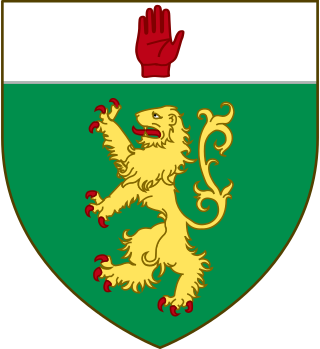Related Research Articles
McMahon, also spelt MacMahon, were different Middle Age era Irish clans. Their name is derived from the Gaelic MacMathghamhna meaning 'son of the bear'.
Standish Hayes O'Grady was an Irish antiquarian. He was born at Erinagh House, Castleconnell, County Limerick, the son of Admiral Hayes O'Grady. He was a cousin of the writer Standish James O'Grady, with whom he is sometimes confused. As a child, he learnt Irish from the native speakers of his locality. He was educated at Rugby School and Trinity College Dublin.

Magennis, also spelled Maguiness, Maginnis, Magenis, McGinnis, or McGuinness, is an Irish surname, meaning the "son of Angus", which in eastern Ulster was commonly pronounced in Irish as Mac Aonghusa. A prominent branch of the Uíbh Eachach Cobha, the Magennises would become chiefs of the territory of Iveagh, which by the 16th century comprised over half of modern County Down, Northern Ireland. By the end of the 17th century, their territory had been divided up between them, the McCartan chiefs and British prospectors.

Airgíalla was a medieval Irish over-kingdom and the collective name for the confederation of tribes that formed it. The confederation consisted of nine minor kingdoms, all independent of each other but paying nominal suzerainty to an overking, usually from the most powerful dynasty. Airgíalla at its peak roughly matched the modern dioceses of Armagh and Clogher, spanning parts of counties Armagh, Monaghan, Louth, Fermanagh, Tyrone and Londonderry. Its main towns were Armagh and Clogher. The name's usage survives as a cultural area of folk tradition in South East Ulster and adjoining areas of County Louth.
Events from the year 1343 in Ireland.
Paul Walsh was an Irish priest and historian.
Events from the year 1592 in Ireland.
Muirgius mac Tommaltaig was a King of Connacht from the Uí Briúin branch of the Connachta. He was the great-grandson of Indrechtach mac Muiredaig Muillethan, a previous king. The death of his father Tommaltach mac Murgail is recorded in the annals where he is called king of Mag nAi. Muirgius was of the Síl Muiredaig sept of the Uí Briúin. He reigned from 792 to 815.
"Le dís cuirthear clú Laighean" is a poem found only in the Tinnakill Duanaire on folio 34r. It was composed for the brothers Aodh Buidhe Mac Domhnaill and Alasdar of Tinnakill, Queen's County, by Muircheartach Ó Cobhthaigh. It dates from about 1570.
Eochaidh Ó hÉoghusa (1567–1617) was a well-known Irish bardic poet.
Foraire Uladh ar Aodh is an Irish poem by Maol Sheachluinn na n-Uirsgéal Ó hUiginn.
Fearghal Óg Mac an Bhaird was a Gaelic-Irish bardic poet.
The Kings of Umaill were rulers of Umaill, a kingdom or territory located in the west of what is now County Mayo, Ireland.
The Kings of Ui Fiachrach Muaidhe were the northern branch of Ui Fiachrach, based on the plain of the Muaidhe.
Áed Ua Forréid was Bishop of Armagh from 1032 to 1056. He was from the Cenél Tigernaig branch of the northern Uí Néill kin-group of Cenél nÉogain. The see was not elevated to an archbishopric until 1106, well after his death.
Aodh Méith or Áed Méith was a 13th-century king of Tír Eoghain. The son of Aodh an Macaoimh Tóinleasg, Aodh spent much of his career fighting off threats from Fir Manach, Tír Conaill and Galloway, as well as John de Courcy and the Lordship of Ireland. His involvement in Irish Sea politics may have seen him sponsor a Mac Uilleim claim to the Scottish throne, but this is unclear.
Muirceartach Ua Peatáin was an Irish chief.

Iveagh is the name of several historical territorial divisions in what is now County Down, Northern Ireland. Originally it was a Gaelic Irish territory, ruled by the Uí Echach Cobo and part of the overkingdom of Ulaid. From the 12th century the Magennises were chiefs of Iveagh. They were based at Rathfriland and were inaugurated at Knock Iveagh. Following the Nine Years' War, the rulers of Iveagh submitted to the English Crown and the territory was divided between them. Iveagh became a barony, which was later split into Iveagh Lower and Iveagh Upper. The territory of Iveagh was also the basis of the Roman Catholic Diocese of Dromore.

Hugh Roe O'Donnell was a leading figure in Gaelic Ireland, ruling as king of Tyrconnell in Ulster from 1461 to 1505. He was then head of the O'Donnell dynasty.
References
- Dublin, Trinity College MS H. 4. 31, ff. 106, 99, 100. For further details see T. K. Abbott and E. J. Gwynn (eds.), Catalogue of the Irish manuscripts in the library of Trinity College, Dublin (Dublin, 1921), entry 1372, p. 223.
- Pól Breathnach, Memoranda Gadelica, Irish Book Lover 19 (Dublin 1931), pp. 166–71.
- Eugene O'Curry, Lectures on the manuscript materials of ancient Irish history (Dublin 1861; repr. Dublin, 1878 and 1995).
- Paul Walsh, The dating of Irish annals, in Irish Historical Studies 2 (1941), pp. 355–75.
- Gearóid Mac Niocaill, The medieval Irish annals (Dublin: DIAS 1975).